|
|
 |
|
Calanoida ( Order ) |
|
|
|
Metridinidae ( Family ) |
|
|
|
Pleuromamma ( Genus ) |
|
|
| |
Pleuromamma gracilis (Claus, 1863) (F,M) | |
| | | | | | | Syn.: | Pleuromma gracile Claus, 1863 (p.197); Giesbrecht, 1892 (p.347, 357, 774, figs.F,M);
no Pleuromamma gracilis : Esterly, 1905 (p.175, Rem.F,M); Farran, 1926 (part.); | | | | Ref.: | | | Giesbrecht & Schmeil, 1898 (p.110, Rem. F); Thompson & Scott, 1903 (p.234, 249); Farran, 1908 b (p.61); A. Scott, 1909 (p.123, Rem.); Wolfenden, 1911 (p.289); Pesta, 1920 (p.528); Steuer, 1925 (p.91, figs.F, M); Sars, 1925 (p.204); Farran, 1926 (p.273); Rose, 1929 (p.30); Farran, 1929 (p.209, 260, figs.F, Rem.); Sewell, 1932 (p.264); Steuer, 1932 a (p.30, 33, 76); 1933 (p.16); Wilson, 1932 a (p.127, figs.F,M); Rose, 1933 a (p.181, figs.F,M); Farran, 1936 a (p.111); Tanaka, 1937 (p.267, figs.F); Mori, 1937 (1964) (p.71, figs.F,M); Lysholm & al., 1945 (p.32); Farran, 1948 f (n°17, p.3, figs.F,M); Delsman, 1949 (p.129); Brodsky, 1950 (1967) (p.308, figs.F,M); Marques, 1953 (p.115); Chiba & al., 1957 (p.308); 1957 a (p.12); Marques, 1959 (p.214); Tanaka, 1960 (p.51); Gaudy, 1962 (p.93, 99, Rem.: p.109, Pl.X: Juv., Tableau 8: development); Grice, 1962 (p.218, figs.F, Rem.); Tanaka, 1963 (p.24, Rem.); Paiva, 1963 (p.55); Chen & Zhang, 1965 (part, p.70-71, figs.F); Vervoort, 1965 (p.108, Rem.); Deevey, 1966 (p.165, Rem.); Saraswathy, 1966 (1967) (p.80); Owre & Foyo, 1967 (p.71, figs.F,M); Vilela, 1968 (p.23, figs.F); Vidal, 1968 (p.33, figs.F,M); Ramirez, 1969 (p.71, figs.F, Rem.); Corral Estrada, 1970 (p.177, figs.M); ); Deevey, 1971 (p.224); Shih & al., 1971 (p.42); Bowman, 1971 b (p.36, figs.F,M, Rem.); Bradford, 1971 b (p.24, fig.F, Rem.); 1972 (p.44, figs.F,M); Razouls, 1972 (p.94, Annexe: p.68, figs.F,M); Kos, 1972 (Vol.I, figs.F,M, Rem.); Arcos, 1975 (p.19, figs.M); Dawson & Knatz, 1980 (p.5, figs.F,M); Björnberg & al., 1981 (p.642, figs.F,M); Zheng & al., 1982 (part. p.46, figs.F,M);Ferrari, 1984 a (p.167, fig.F); J.S. Park & Mauchline, 1994 (p.108 & suiv.,fig.F); J.S. Park, 1995 (p.212, figs.); Chihara & Murano, 1997 (p.838, tab.7, Pl.131: F,M); Cuoc & al., 1997 (p.656, fig.F: genital complex); Bradford-Grieve & al., 1999 (p.884, 949, figs.F,M); Bradford-Grieve,1999 b (p.121, figs.F,M, Rem., figs.179, 192); Conway & al., 2003 (p.92, Figs.F,M, Rem); G. Harding, 2004 (p.31, figs.F,M); Mulyadi, 2004 (p.61, figs.F,M, Rem.); Conway, 2006 (p.19, copepodides 1-6, Rem.); Ferrari & Dahms, 2007 (p.35, Rem. N, biolum.); Avancini & al., 2006 (p.93, Pl. 62, figs.F,M, Rem.); Vives & Shmeleva, 2007 (p.377, figs.F,M, Rem.); Halbert & al., 2013 (p.1, fig.5, DNA sequence, Rem.: cryptic forms); Blanco-Bercial & al., 2014 (p.6, Rem.: problematical for barcoding) |  isued from : J.M. Bradford-Grieve in The Marine Fauna of New Zealand: Pelagic Calanoid Copepoda. National Institute of Water and Atmospheric Research (NIWA). NIWA Biodiversity Memoir, 111, 1999. [p.121, Fig.82]. Female (from 41°41'S, 167°03'E): A, habitus (dorsal); B, urosome (left lateral side); C, P5. Male: D, habitus (dorsal); E, P5. Female characteristics: Pigment spot on right side. - Proximal segments of A1 with small low denticles. - P5 2-segmented (with 1 free segment); distal segment with 3 terminal spines and 2 thin outer spines. Male characteristics: Pigment spot on right side. - Urosome almost completely symmetrical except that segment 3 has a patch of hairs on left distolateral border. - Left A1 geniculate; toothed ridges on segments 17, 18 and 19-21; serrations are variable, teeth can be pointed or more or less blunt, long and thin, or short and thick. - Endopod segment 1 of P2 with denticles on right side only. - Distal segment of right P5 elongate, slightly less wide than in other related forms; penultimate segment of same leg has a curvede process with a double row of blunt tubercles.
|
 issued from: Q.-c Chen & S.-z. Zhang in Studia Marina Sinica, 1965, 7. [Pl.24, 1-4]. As Pleuromamma gracilis Forma typica. Female (from E China Sea): 1, habitus (dorsal); 2, forehead (lateral); 3, urosome (ventral); 4 idem (lateral right side).
|
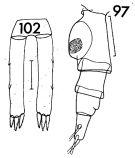 issued from : F.C. Ramirez in Contr. Inst. Biol. mar., Buenos Aires, 1969, 98. [p.70, Lam. XIII, figs.97, 102]. Female (from off Mar del Plata): 97, urosome (lateral left side); 102, P5. Scale bars in mm: 0.5 (97); 0.05 (102).
|
 issued from : J. Corral Estrada in Tesis Doct., Univ. Madrid, A-129, Sec. Biologicas, 1970. [Lam.48, figs.2-3]. Male (from Canarias Is.): 2, right A1 (grasping segments); 3, P5.
|
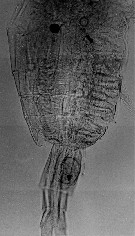 issued from : F. Giron-Reguer in Thèse Fac. Sc. Paris, 1963 [Fig.11]. Female (from Alboran Sea): thoracic segments and abdomen (ventro-lateral right side). Nota: see the length of P5 and the genital complex.
|
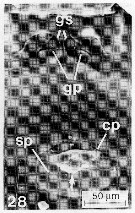 issued from : C. Cuoc, D. Defaye, M. Brunet, R. Notonier & J. Mazza in Mar. Biol., 1997, 129. [p.655, Figs.14-18]. Scanning electron micrograph of genital area of females (from Banyuls, France). 28, outer genital area of inseminated female; note pedunculate structure (arrow) on spermatophoral plug ( sp. gp: gonoporal plate; gs: gonoporal slits.
|
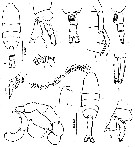 issued from : Z. Zheng, S. Li, S.J. Li & B. Chen in Marine planktonic copepods in Chinese waters. Shanghai Sc. Techn. Press, 1982 [p.48, Fig.27-1]. As Pleuromamma gracilis f. minima. Female: a, habitus (dorsal); b, forehead (lateral); c-d, urosome (lateral and ventral, respectively); e, proximal segments of A1; f, P2; g, basipodite, exopodal segment 1 and endopod of P2; h, P5. Male: i, habitus (dorsal); j, grsping segments of left A1; k, basipodite, exopodal segment 1 and endopod of P2; l, P5. Scale bars in mm.
|
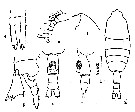 issued from : Z. Zheng, S. Li, S.J. Li & B. Chen in Marine planktonic copepods in Chinese waters. Shanghai Sc. Techn. Press, 1982 [p.49, 27-2, f-q). As Pleuromamma gracilis f. maxima. Female: k, habitus (dorsal); l, forehead (lateral); m-n, urosome (lateral and ventral, respectively); 0, proximal segments of A1; p, basipodite, exopodal segment 1 and endopod of P2; q, P5.
|
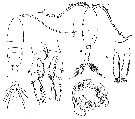 issued from : T. Mori in The pelagic Copepoda from the neighbouring waters of Japan, 1937 (2nd edit., 1964). [Pl.35, Figs.1-5]. Female: 1, habitus (dorsal); 4, P5. Male: 2, P5 (posterior); 3, habitus (dorsal); 5, P2 (anterior).
|
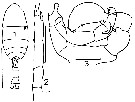 issued from : J.M. Bradford in Mem. N. Z. Oceonogr. Inst., 1972, 54. [p.45, Fig.11, (-3]. Female (from Kaikoura, New Zealand): 1, habitus (dorsal); 2, P5. Male: 3, P5. Scale bars: 1 mm (1); 0.1 mm (2, 3). Nota: The form was forma maxima (Steuer, 1932) which has 2-segmented female P5.
|
 issued from : C. Razouls in Th. Doc. Etat Fac. Sc. Paris VI, 1972, Annexe. [Fig.51]. Female (from Banyuls, G. of Lion): A, P5; B, P5 (anomaly); C, urosome (dorsal); C', last segment of metasome and genital segment (lateral). Male: D, last segment of metasome and urosome (dorsal); E, exopod of right P5, E' process on exopodal segment 1 of right P5 (various views); F, geniculation on right A1.
|
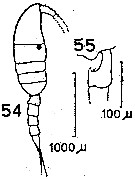 issued from : D.F.R. Arcos in Gayana, Zool., 1975, 32. [Lam.VI, Figs.54-55]. Female (from Bahia de Concepcion, Chile): 54, habitus (lateral) [ Juvenile ? ]. 55, endopodite segment 1 of P2.
|
 issued from : D.F.R. Arcos in Gayana, Zool., 1975, 32. [Lam.V, Figs.52-53]. Male: 52, habitus (dorsal); 53, P5.
|
 issued from : T.E. Bowman in Smithson. Contr. Zool., 1971, 96. [p.44, Fig.39, e-h]. Female (from Florida): e-f, urosome (dorsal and lateral, respectively); g, P5; h, P5 (terminal spines).
|
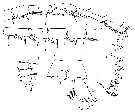 issued from : T.E. Bowman in Smithson. Contr. Zool., 1971, 96. [p.43, Fig.38, e-i]. Male: e, distal segments of left A1; f, segments 13-16 of left A1; g, posterior segments of prosome (lateral), showing position of spermatophore; h, anal segment and caudal ramus (dorsal); i, Md (cutting edge).
|
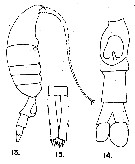 issued from : G.D. Grice in Fish. Bull. Fish and Wildl. Ser., 1962, 61. [p.217, Pl.22, Figs.13-15]. As Pleuromamma gracilis f. minima. Female (from equatorial Pacific): 13, habitus (lateral); 14, urosome (ventral); 15, P5. Nota: Divergent margins of the anal segment. Fused 2nd basal and exopodal segments of P5 In most of the present specimens the left caudal ramus is enlarged.
|
 issued from : G. Harding in Key to the adullt pelagic calanoid copepods found over the continental shelf of the Canadian Atlantic coast. Bedford Inst. Oceanogr., Dartmouth, Nova Scotia, 2004. [p.31]. Female & Male. Nota: Male; P5 with a longer knobbed process (arrowed) on exopodal segment 2 than in P. borealis.
|
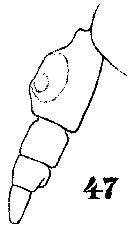 Issued from : W. Giesbrecht in Systematik und Faunistik der Pelagischen Copepoden des Golfes von Neapel und der angrenzenden Meeres-Abschnitte. – Fauna Flora Golf. Neapel, 1892, 19 , Atlas von 54 Tafeln. [Taf.33, Fig.47]. As Pleuromma gracile. Female: 47, urosome (lateral).
|
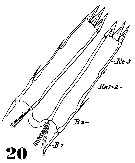 Issued from : W. Giesbrecht in Systematik und Faunistik der Pelagischen Copepoden des Golfes von Neapel und der angrenzenden Meeres-Abschnitte. – Fauna Flora Golf. Neapel, 1892, 19 , Atlas von 54 Tafeln. [Taf.32, Fig.20]. As Pleuromma gracile. Female: 20, P5.
|
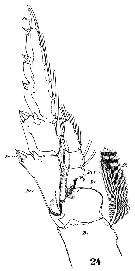 Issued from : W. Giesbrecht in Systematik und Faunistik der Pelagischen Copepoden des Golfes von Neapel und der angrenzenden Meeres-Abschnitte. – Fauna Flora Golf. Neapel, 1892, 19 , Atlas von 54 Tafeln. [Taf.32, Fig.24]. As Pleuromma gracile. Female: 24, P2 (anterior view).
|
 Issued from : W. Giesbrecht in Systematik und Faunistik der Pelagischen Copepoden des Golfes von Neapel und der angrenzenden Meeres-Abschnitte. – Fauna Flora Golf. Neapel, 1892, 19 , Atlas von 54 Tafeln. [Taf.32, Fig.4]. As Pleuromma gracile. Female: 4, Mx1 (posterior view).
|
 Issued from : W. Giesbrecht in Systematik und Faunistik der Pelagischen Copepoden des Golfes von Neapel und der angrenzenden Meeres-Abschnitte. – Fauna Flora Golf. Neapel, 1892, 19 , Atlas von 54 Tafeln. [Taf.32, Fig.17]. As Pleuromma gracile. Female: 17, Mxp (anterior view).
|
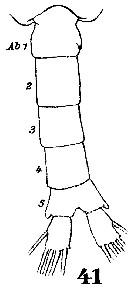 Issued from : W. Giesbrecht in Systematik und Faunistik der Pelagischen Copepoden des Golfes von Neapel und der angrenzenden Meeres-Abschnitte. – Fauna Flora Golf. Neapel, 1892, 19 , Atlas von 54 Tafeln. [Taf.33, Fig.41]. As Pleuromma gracile. Male: 41, urosome.
|
 Issued from : W. Giesbrecht in Systematik und Faunistik der Pelagischen Copepoden des Golfes von Neapel und der angrenzenden Meeres-Abschnitte. – Fauna Flora Golf. Neapel, 1892, 19 , Atlas von 54 Tafeln. [Taf.32, Fig.6]. As Pleuromma gracile. Male: 6, A1 (proximal segments 1 to 12-13; ventral view).
|
 Issued from : W. Giesbrecht in Systematik und Faunistik der Pelagischen Copepoden des Golfes von Neapel und der angrenzenden Meeres-Abschnitte. – Fauna Flora Golf. Neapel, 1892, 19 , Atlas von 54 Tafeln. [Taf.32, Fig.6]. As Pleuromma gracile. Male: 6, A1 (distal segments 12-13 to 24-25; ventral view).
|
 Issued from : W. Giesbrecht in Systematik und Faunistik der Pelagischen Copepoden des Golfes von Neapel und der angrenzenden Meeres-Abschnitte. – Fauna Flora Golf. Neapel, 1892, 19 , Atlas von 54 Tafeln. [Taf.32, Figs.18, 19]. As Pleuromma gracile. Male: 18, right P5 (exopodal segments); 19, left P5 (exiopodal segments 1 and 2). Ps = left leg; Pd = righjt leg; Re = exopod.
|
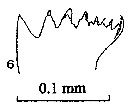 issued from : P.E. Lapernat & C. Razouls in Vie Milieu, 2002, 52 (1). [p.28, Pl. VI, fig.6]. Masticatory edge of Md gnathobase female (from off Malta, Mediterranean Sea). Nota: Itoh's index: 582.2 (number of teeth : 8) for the masticatory edge of the right Md, and 608.3 (number of teeth : 8) on the masticatory edge of the left Md.
|
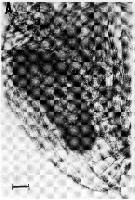 issued from : A. Ianora, B. Scotto di Carlo, M.G. Mazzocchi & P. Mascellaro in J. Plankton Res., 1990, 12 (2). [p.253, Fig.4, A]. Pleuromamma gracilis female (from Gulf of Naples, Italy) parasitized by the dinoflagellate Blastodinium, less than 1 % throughout the year. Scale bar = 0.100 mm.
|
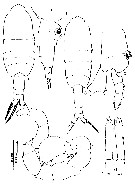 issued from : Mulyadi in Published by Res. Center Biol., Indonesia Inst. Sci. Bogor, 2004. [p.63, Fig.35]. Female (from Flores Sea): a, habitus (dorsal); b, urosome (lateral); c, P2 (exopod segments 2 and 3 missing); d, P5. Male: e, habitus (dorsal); f, P5.
|
 Issued from : J.M. Bradford in N.Z. Oceanogr. Inst., 1971, 206, Part 8, No 59. [p.22, Fig.88]. As Pleuromamma gracilis forma maxima. Female (from 75°17'S, 172°20'E): 88, P5. Scale bar: 100 µm. Nota: The occurrence of this specimen is anomalous, although Farran (1929) recorded it as far south as 52°S.
|
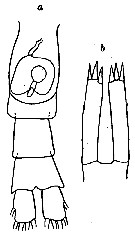 Issued from : O. Tanaka in Japanese J. Zool., 1937, VII, 13. [p.267, Fig.15]. Female (from coast of Heda, Japan): a, abdomen (ven,tral); b, P5.
|
 Issued from : M.G. Mazzocchi in Guida al Riconoscimento del plancton dei Mari Italiani, Vol. II, 2006. [p.70, Tav. 62]. Redrawn after Rose, 1933; Steuer, 1933. Female: a, habitus (dorsal); b-c, urosome (ventral and lateral, respectively); d, proximal part of A1; e, P5. male: f, urosome (ventral); g, distal part of left A1; h, P5.
|
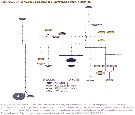 Issued from : L. Blanco-bercial, A. Cornils, N. Copley & A. Bucklin in PLoS Currents, 2014, Version 1, p.8]. TCS analysis on the Pleuromamma piseki and Pleuromamma gracilis sequences. For the authors: The clade containing P. gracilis and P. piseki was recovered with 100% bootstrap support, but the species formed a number of clusters and MOTUs. A detailed analysis of these two taxa showed a complex pattern, with strong regional-scale genetic structuring of P. gracilis, but no clear isolation from P. piseki . P. gracilis from the SE Atlantic showed a number of highly divergent haplotypes, but still no amino acid substitutions. Regional-scale genetic structure and the presence of highly-divergent rare haplotypes may be related to the large effective population size of cosmopolitan marine copepods. In contrast P. piseki did not show strong spatial structure and lacked genetic divergence from P. gracilis. Similar results have been recently reported for the same species complex for other mitochondrial markers (see Halbert, Goetze & Carlon, 2013). Clearly, integrated molecular and morphological analysis of both species throughout their distributional ranges is needed to clarify both the status of the species and their population structure.
| | | | | Compl. Ref.: | | | Cleve, 1904 a (p.195); Rose, 1924 d (p.479); 1925 (p.152); Hardy & Gunther, 1935 (1936) (p.167, Rem.); Wilson, 1942 a (p.202); Massuti Alzamora, 1942 (p.91); Oliveira, 1945 (p.191); Sewell, 1948 (p.349, 503, 508, 512, 514, 516, 519, 525, 547, 549, 557, 567); C.B. Wilson, 1950 (p.289); Kott, 1957 (p.5, 17); Yamazi, 1958 (p.150, Rem.); Wickstead, 1962 (p.550, food & feeding); Fagetti, 1962 (p.27); Grice & Hart, 1962 (p.287, table 3); Duran, 1963 (p.19); Giron-Reguer, 1963 (p.32; V.N. Gaudy, 1963 (p.25, Rem.); Greze, 1963 a (tabl.2); Shmeleva, 1963 (p.141); Grice, 1963 a (p.496); Ahlstrom & Thrailkill, 1963 (p.57, Table 5, abundance); Björnberg, 1963 (p.50, Rem.); Bary, 1963 a (p.1519, Table 1); 1964 (p.183, T-S diagram-occurrences, Rem.: p.198); De Decker, 1964 (p.16, 24, 28); De Decker & Mombeck, 1964 (p.13); Shmeleva, 1965 b (p.1350, lengths-volume -weight relation); Pavlova, 1966 (p.44); Deevey, 1966 (p.155, fig.3, lengths variation); Mullin, 1966 (p.546, Table I, III, diet); Furuhashi, 1966 a (p.295, vertical distribution vs mixing Oyashio/Kuroshio region, Table 8, 9); Mazza, 1966 (p.71); 1967 (p.367); Ehrhardt, 1967 (p.738, geographic distribution, Rem.); Fleminger, 1967 a (tabl.1); De Decker, 1968 (p.45); Evans, 1968 (p.14); Berdugo & Kimor, 1968 (p.447); Vinogradov, 1968 (1970) (p.81, 82, 83, 84, 91, 277); Dowidar & El-Maghraby, 1970 (p.269); Timonin, 1971 (p.281, trophic group); Carli, 1971 (p.373, tab.2); Bainbridge, 1972 (p.61, Appendix Table I: vertical distribution vs. day/night, Table II: %); Binet & al., 1972 (p.69); Boucher & Thiriot, 1972 (p.47, Tableau 4); Apostolopoulou, 1972 (p.328, 354, fig.5); Roe, 1972 (p.277, tabl.1, tabl.2); 1972 b (p.550, Rem.); Razouls S., 1972 b (p.2, respiration); Nival & al., 1972 (p.63, respiration); Björnberg, 1973 (p.338, 388); S. Razouls, 1974 (147, oxygen rate); Corral Estrada & Pereiro Muñoz, 1974 (tab.I); Harding, 1974 (p.141, tab. 3, gut contents); de Bovée, 1974 (p.109, 124); Vives & al., 1975 (p.46, tab.II, III, IV); Fernandez, 1975 (p.1, fig.11, 12, 13, 14, metabolism/lux), Tranter, 1977 (p.596, 602); Timonin & Voronina, 1977 (p.291); Deevey & Brooks, 1977 (p.256, tab.2, Station "S"); Carter, 1977 (1978) (p.36); Arashkevich, 1978 (p.118, Table: diets); Fernandez, 1978 (p.97, metabolism/food, Rem.: Table 19); Dessier, 1979 (p. 206); Vaissière & Séguin, 1980 (p.23, tab.2); Hayward, 1980 (p.295, Table 2, vertical distribution, feeding); Vives, 1982 (p.293); Rudyakov, 1982 (p.208, Table 2); Kovalev & Shmeleva, 1982 (p.84); Scotto di Carlo & Ianora, 1983 (p.150); Dessier, 1983 (p.89, Tableau 1, 2, Rem., %); Roe, 1984 (p.358); Guangshan & Honglin, 1984 (p.118, tab.); Sameoto, 1984 (p.767, as glacilis, vertical migration); Tremblay & Anderson, 1984 (p.5); De Decker, 1984 (p.316, 360: chart); Binet,1984 (tab.2, 3); Boucher, 1984 (p.469, spatial distribution/hydrological front); Scotto di Carlo & al., 1984 (1041); Cummings, 1984 (p.163, Table 2); Sazhina, 1985 a (p.491, tab.2); Petipa & Borichenko, 1985 (tab.2); Regner, 1985 (p.11, Rem.: p.35); Brenning, 1985 a (p.28, Table 2); Longhurst, 1985 (tab.2); Brinton & al., 1986 (p.228, Table 1); Chen Y.-Q., 1986 (p.205, Table 1: abundance %, fig.10, Table 2: vertical distribution); M. Lefèvre, 1986 (p.33); Wishner Allison, 1986 (tab.2); Madhupratap & Haridas, 1986 (p.105, tab.1); Brenning, 1986 (p.9, spatial distribution, T-S Diagram, Rem.); Saraswathy, 1986 (p.189); Ambler & Miller, 1987 (tab.2, 3, 4, 5); Wiebe & al., 1988 (tab.7); Jimenez-Perez & Lara-Lara, 1988; Lozano Soldevilla & al., 1988 (p.59); Dessier, 1988 (tabl.1); Cervantes-Duarte & Hernandez-Trujillo, 1989 (tab.3); Buskey & al., 1989 (p.207, vertical distribution vs light penetration); Suarez & al., 1990 (tab.2); Hirakawa & al., 1990 (tab.3); Madhupratap & Haridas, 1990 (p.305, fig.4: vertical distribution night/day; fig.7: cluster); Ianora & al., 1990 (p.249, fig., parsitism effects); Yoo, 1991 (tab.1, as glacilis); Park & al., 1991 (p.203); Hattori, 1991 (tab.1, Appendix); Scotto di Carlo & al., 1991 (p.270); Suarez & Gasca, 1991 (tab.2); Hernandez-Trujillo, 1991 (1993) (tab.I); Suarez, 1992 (App.1); Heinrich, 1992 (p.86); Ayukai & Hattori, 1992 (p.163, Table 5, fecal pellet production rate); Jiyalal Ram & Goswami, 1993 (p.129, tab.IV); Ashjian & Wishner, 1993 (p.483, abundance, species group distributions); Seguin & al., 1993 (p.23); Kouwenberg, 1993 a (p.281, fig.3, 4, sex ratio); Hays & al., 1994 (tab.1); Landry & al., 1994 (p.55, abundance, grazing); Kouwenberg, 1994 (tab.1); Genin & al., 1994 (p.941, fig.5, patchiness); Heinrich, 1995 (tab.1); Palomares Garcia & Vera, 1995 (tab.1); Shih & Young, 1995 (p.71); Kotani & al., 1996 (tab.2); Suarez-Morales & Gasca, 1997 (p.1525); Timonin, 1997 (p.83, Rem.); Park & Choi, 1997 (Appendix); Hure & Krsinic, 1998 (p.102, 112); Gilabert & Moreno, 1998 (tab.1, 2); Alvarez-Cadena & al., 1998 (tab.2, 4); Mauchline, 1998 (tab.30, 33, 58, 63); Noda & al., 1998 (p.55, Table 3, occurrence); Reid & Hunt, 1998 (p.310, figs.2, 3, Rem.); Suarez-Morales, 1998 (p.345, Table 1); Suarez-Morales & Gasca, 1998 a (p.110); Siokou-Frangou, 1999 (p.476); Lavaniegos & Gonzalez-Navarro, 1999 (p.239, Appx.1); Harvey & al., 1999 (p.1, 49: Appendix 5, in ballast water vessel); Onishchik, 1999 (p.76, fig.2); Lapernat, 2000 (tabl. 3, 4); Razouls & al., 2000 (p.343, tab. 5, Appendix); Fernandez-Alamo & al., 2000 (p.1139, Appendix); Escribano & Hidalgo, 2000 (p.283, tab.2); Plounevez & Champalbert, 2000 (p.175, Table III, IV, V, abundance vs fish); Sautour & al., 2000 (p.531, Table II, abundance); Suarez-Morales & Gasca, 2000 (1247, tab.1); Seridji & Hafferssas, 2000 (tab.1); Lopez-Salgado & al., 2000 (tab.1); Moraitou-Apostolopoulou & al., 2000 (tab.I, fig.8); Plounevez & Champalbert, 2000 (p.175, Table III, IV, V, abundance vs fish); Haury & al., 2000 (p.69, Table 1); Madhupratap & al., 2001 (p. 1345, vertical distribution vs. O2, figs.4, 5: clusters, p.1353); d'Elbée, 2001(tabl. 1); Rebstock, 2001 (tab.2); Holmes, 2001 (p.20); Hidalgo & Escribano, 2001 (p.159, tab.2); Hidalgo & Escribano, 2001 (p.158, fig.5); Rebstock, 2002 (p.71, Table 3, 5, 6, Figs.2, 3, climatic variability); Beaugrand & al., 2002 (p.1692); Beaugrand & al., 2002 (p.179, figs.5, 6); Gaudy & al., 2003 (p.357, tab.1); Vukanic, 2003 (139, tab.1); Hsiao & al., 2004 (p.326, tab.1); Hsieh & al., 2004 (p.397, tab.1); Lan & al., 2004 (p.332, tab.1); Lo & al.*, 2004 (p.218, fig.6); Pusch & al., 2004 (251, tab.3); Gallienne & al., 2004 (p.5, tab.3); CPR, 2004 (p.60, fig.177); Lo & al., 2004 (p.89, tab.1); Wang & Zuo, 2004 (p.1, Table 2, dominance, origin); Vukanic & Vukanic, 2004 (p.9, tab. 2, 3); Shimode & al., 2005 (p.113 + poster); Berasategui & al., 2005 (p.313, fig.2); Berasategui & al., 2005 (p.485, tab.1); Berasategui & al., 2006 (p.485: fig.2); Zuo & al., 2006 (p.159, tab.1, abundance, fig.8: stations group); Isari & al., 2006 (p.241, tab.II); Hwang & al., 2006 (p.943, tabl. I) ; Dias & Araujo, 2006 (p.56, Rem., chart); Lavaniegos & Jiménez-Pérez, 2006 (p.152, tab.2, 3, Rem.); Mackas & al., 2006 (L22S07, Table 2); Zervoudaki & al., 2006 (p.149, Table I); Escribano, 2006 (p.20, Table 1); Koppelmann & Weikert, 2007 (p.266: tab.3); Hwang & al., 2007 (p.24); Dur & al., 2007 (p.197, Table IV); Valdés & al., 2007 (p.104: tab.1); Morales C.E. & al., 2007 (p.452, Rem.: p.462: abundance); Khelifi-Touhami & al., 2007 (p.327, Table 1); McKinnon & al., 2008 (p.844: Tab.1); Lopez Ibarra, 2008 (p.1, Table 1, 2, figs.11, 16: abundance, Table 3: N, C isotopes, figs.17, 18, 19, 20, 25, 26, Annexe 2, Table 4: index trophic); Cabal & al., 2008 (289, Table 1); Neumann-Leitao & al., 2008 (p.799: Tab.II, fig.6); Morales-Ramirez & Suarez-Morales, 2008 (p.520); Ayon & al., 2008 (p.238, Table 4: Peruvian samples); Fernandes, 2008 (p.465, Tabl.2); Gaard & al., 2008 (p.59, Table 1, N Mid-Atlantic Ridge); Raybaud & al., 2008 (p.1765, Table A1); Tseng L.-C. & al., 2008 (p.153, Table 2, fig.5, occurrence vs geographic distribution, indicator species); Tseng & al., 2008 (p.402, Table 2); Lan Y.-C. & al., 2008 (p.61, Table 1, % vs stations, Table 2: indicator species); C.-Y. Lee & al., 2009 (p.151, Tab.2); Galbraith, 2009 (pers. comm.); Tseng & al., 2009 (p.327, fig.5, feeding); Zhang W & al., 2009 (p.261); Zhang W & al., 2009 (p.263); Licandro & Icardi, 2009 (p.17, Table 4); Lan Y.-C. & al., 2009 (p.1, Table 2, % vs hydrogaphic conditions); Escribano & al., 2009 (p.1083, Table 1, figs.6, 10); C.E. Morales & al., 2010 (p.158, Table 1); Brugnano & al., 2010 (p.312, Table 3, fig.8); Williamson & McGowan, 2010 (p.273, Table III, Pacific central gyres: N & S); Schnack-Schiel & al., 2010 (p.2064, Table 2: E Atlantic subtropical/tropical); Hidalgo & al., 2010 (p.2089, fig.2, 4, Table 2, cluster analtsis); Dias & al., 2010 (p.230, Table 1); Mazzocchi & Di Capua, 2010 (p.426); Medellin-Mora & Navas S., 2010 (p.265, Tab. 2); Nowaczyk & al;, 2011 (p.2159, Table 2); Pepin & al., 2011 (p.273, Table 2, seasonal abundance); Xu & Gao, 2011 (p.514, figs.3, 4, Table 2: optimal salinity); Hsiao S.H. & al., 2011 (p.475, Appendix I); Hsiao & al., 2011 (p.317, Table 2, indicator of seasonal change); Tutasi & al., 2011 (p.791, Table 2, abundance distribution vs La Niña event); Tseng L.-C. & al., 2011 (p.47, Table 2, occurrences vs mesh sizes); Pillai H.U.K. & al., 2011 (p.239, Table 3, vertical distribution); Andersen N.G. & al., 2011 (p.71, Fig.3: abundance); Selifonova, 2011 a (p.77, Table 1, alien species in Black Sea); Shiganova & al., 2012 (p.61, Table 4); Brugnano & al., 2012 (p.207, Table 2, 3); Uysal & Shmeleva, 2012 (p.909, Table I); Salah S. & al., 2012 (p.155, Tableau 1); Jang M.-C & al., 2012 (p.37, abundance and seasonal distribution); Mulyadi & Rumengan, 2012 (p.202, Rem.: p.204); Tseng & al., 2012 (p.621, Table 3: abundance); Hidalgo & al., 2012 (p.134, Table 2, 3, fig.8: occurrence vs hydrology); Minutoli & Guglielmo, 2012 (p.91, carbon requirement vs vertical distribution); Gubanova & al., 2013 (in press, p.4, Table 2); Siokou & al., 2013 (p.1313, fig.4, 8, biomass, vertical distribution); Belmonte & al., 2013 (p.222, Table 2, abundance vs stations); Palomares-Garcia & al., 2013 (p.1009, Table I, fig.7, abundance vs environmental factors); in CalCOFI regional list (MDO, Nov. 2013; M. Ohman, comm. pers.); Kobari & al., 2013 (p.78, Table 2); Tseng & al., 2013 (p.507, seasonal abundance); Tseng & al., 2013 a (p.1, Table 3, 4, abundance); Wishner & al., 2013 (p.122, diel vertical migration); Sobrinho-Gonçalves & al., 2013 (p.713, Table 2, fig.8, seasonal abundance vs environmental conditions); Hirai & al., 2013 (p.1, Table I, molecular marker); Sano & al., 2013 (p.11, Table 2, feeding habits); Mendoza Portillo, 2013 (p.37: Fig.7, seasonal dominance, p.42: fig.10, biomass); Lidvanov & al., 2013 (p.290, Table 2, % composition); Hwang & al., 2014 (p.43, Appendix A: seasonal abundance); Fernandez de Puelles & al., 2014 (p.82, Table 3, seasonal abundance); Bonecker & a., 2014 (p.445, Table II: frequency, horizontal & vertical distributions); Lopez-Ibarra & al., 2014 (p.453, fig.6, Table 2, biogeographical affinity); Mazzocchi & al., 2014 (p.64, Table 3, 4, 5, spatial & seasonal composition %); Pino-Pinuer & al., 2014 (p.83, Table 1, 2, fig.3, abundance variation vs time); Fierro Gonzalvez, 2014 (p.1, Tab. 3, 5, occurrence, abundance); Zaafa & al., 2014 (p.67, Table I, occurrence); Dias & al., 2015 (p.483, Table 2, abundance, biomass, production); Zakaria & al., 2016 (p.1, Table 1) ; Benedetti & al., 2016 (p.159, Table I, fig.1, functional characters); El Arraj & al., 2017 (p.272, table 2, spatial distribution); Benedetti & al., 2018 (p.1, Fig.2: ecological functional group); Belmonte, 2018 (p.273, Table I: Italian zones); Chaouadi & Hafferssas, 2018 (p.913, Table II: occurrence); Dias & al., 2018 (p.1, Table 4: % vs. season); Hure M. & al., 2018 (p.1, Table 1: abundance, % composition, Rem.: p.12); Palomares-Garcia & al., 2018 (p.178, Table 1: occurrence); Acha & al., 2020 (p.1, Table 3: occurrence % vs ecoregions, Table 5: indicator ecoregions). | | | | NZ: | 22 | | |
|
Distribution map of Pleuromamma gracilis by geographical zones
|
| | | | | | | | | | | | | | |  issued from : M. Saraswathy in Mahasagar-Bull. Nat. Inst. Oceanogr., 1986, 19 (3). [p.187, Fig.1B]. issued from : M. Saraswathy in Mahasagar-Bull. Nat. Inst. Oceanogr., 1986, 19 (3). [p.187, Fig.1B].
Distribution of P. gracilis in the Indian Ocean (upper water column of 200 m).
Triangle: South West Moonsoon season: April 16 to October 15 (white triangle = negative stations; black = animals collected). Circle: North East Moonsoon season: October 16 to April 15 (white circle = negative stations; black = numbers of ianimals collected).
Nota: Tis species was found to be most abundant off the Somalia coast. |
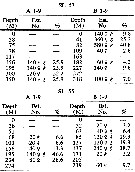 issued from : H.B. Owre & M. Foyo in Fauna Caribaea, 1, Crustacea, 1: Copepoda. Copepods of the Florida Current. 1967. [p.73, Table 29]. issued from : H.B. Owre & M. Foyo in Fauna Caribaea, 1, Crustacea, 1: Copepoda. Copepods of the Florida Current. 1967. [p.73, Table 29].
Vertical distribution of Pleuromamma gracilis at the ''40-Mile station'' in the Florida Current (± 25°35'N, 79°27'W).
SL 53: 18 V 1958; SL 55: 21 VII 1958. A: during midday; B;: during midnight. |
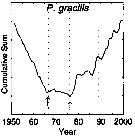 issued from : G.A. Rebstock in Global change Biology, 2002, 8. [p.77, Fig.2 l ]. issued from : G.A. Rebstock in Global change Biology, 2002, 8. [p.77, Fig.2 l ].
Climatic regime shifts and decadal-scale variability in calanoid copepod populations off southern California (31°-35°N, 117°-122°W.
Cumulative sums of nonseasonal anomalies from the long-term means of copepod abundance from years 1950 to 2000.
A negative slope indicates a period of below-average anomalies; a positive slope indicates a period of above-average anomalies. Abrupt changes in slope indicate step changes. Step changes are marked with arrows (downward -pointing for decreases).
The October 1966 cruise (prior to the increase in sampling depth), March 1976 cruise (prior to the 1976-77 climatic regime shift), and October 1988 cruise (prior to the hypothesized 1989 climatic regime shift) are marked with vertical lines. |
 issued from : A.A. Shmeleva in Bull. Inst. Oceanogr., Monaco, 1965, 65 (n°1351). [Table 6: 25 ]. Pleuromamma gracilis (from South Adriatic). issued from : A.A. Shmeleva in Bull. Inst. Oceanogr., Monaco, 1965, 65 (n°1351). [Table 6: 25 ]. Pleuromamma gracilis (from South Adriatic).
Dimensions, volume and Weight wet. Means for 50-60 specimens. Volume and weight calculated by geometrical method. Assumed that the specific gravity of the Copepod body is equal to 1, then the volume will correspond to the weight. |
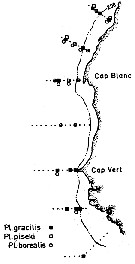 issued from : U. Brenning in Wiss. Z. Wilhelm-Pieck-Univ. Rostock - 35. Jahrgang 1986. Mat.-nat. wiss. Reihe, 5. [p.8, Fig.5]. issued from : U. Brenning in Wiss. Z. Wilhelm-Pieck-Univ. Rostock - 35. Jahrgang 1986. Mat.-nat. wiss. Reihe, 5. [p.8, Fig.5].
Spatial distribution for Pleuromamma gracilis, P. piseki and P. borealis from 8° S - 26° N; 16°- 20° W. |
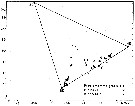 issued from : U. Brenning in Wiss. Z. Wilhelm-Pieck-Univ. Rostock - 35. Jahrgang 1986. Mat.-nat. wiss. Reihe, 5. [p.10, Fig.7]. issued from : U. Brenning in Wiss. Z. Wilhelm-Pieck-Univ. Rostock - 35. Jahrgang 1986. Mat.-nat. wiss. Reihe, 5. [p.10, Fig.7].
T-S Diagram for Pleuromamma gracilis, P. piseki and P. borealis from 8° S - 26° N; 16°- 20° W.
SO: Southern Surface Water (S °/oo: 34,50; T°C: 29,0); ND: Northern Water of the Surface Layer (S °/oo: 37,5; T°C: 21,0); SD: Southern Deep Water of the surface layer (S °/oo: 35,33; T°C: 13,4). See commentary in Temora stylifera and Brenning (1985 a, p.6). |
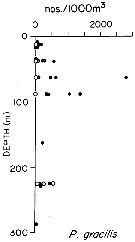 issued from : T.L. Hayward in Mar. Biol., 1980, 58. [p.299, Fig.2]. issued from : T.L. Hayward in Mar. Biol., 1980, 58. [p.299, Fig.2].
Plots of day (open circle) and night (filled circle) depth distributions of Pleuromamma gracilis in the North Pacific central gyre (main sampling location: 25°N, 155°W with drogue), September 1968. |
 issued from : T.L. Hayward in Mar. Biol., 1980, 58. [p.302, Fig.4]. issued from : T.L. Hayward in Mar. Biol., 1980, 58. [p.302, Fig.4].
Day and night feeding indices (relative degree of gut fullness of copepods collected under differing environmental conditions) for females Pleuromamma gracilis from N Pacific central gyre (main sampling location: 28°N, 155°W), June 1973.
Numbers in abscisse : stations. |
 Issued from : P.-E. Lapernat in DEA Océanogr. Biol., Univ. P. & M. Curie, Paris VI. July 5, 2000. [Fig.10 e]. Issued from : P.-E. Lapernat in DEA Océanogr. Biol., Univ. P. & M. Curie, Paris VI. July 5, 2000. [Fig.10 e].
Verical distribution of Pleuromamma gracilis at an oligotrophe site (off NW Cape Verde Islands: 21° N, 31° W) in females (F) and males (M) (ind. per m3) in the day (white circle) and night (black circle).
Nota: Sampling in the water column 0-1000 m, one during the day and another during the night with BIONESS multiple-net: 0-75; 75-150; 150-250; 250-350; 350-450; 450-550; 550-700; 700-850; 850-965 m. In May-June 1992. |
 Issued from S. Razouls in XXIII rd Congress of Athens, 3-11 November 1972. [p.2]. Oxygen consumed by individual (adult) in the Banyuls Bay and equivalent carbon asked. Issued from S. Razouls in XXIII rd Congress of Athens, 3-11 November 1972. [p.2]. Oxygen consumed by individual (adult) in the Banyuls Bay and equivalent carbon asked.
(1) Hydrological season in the stability period: Eté = Summer: 18-20 °C; Hiver = Winter: 13-10°C.
Espèces = species; Saison = Season; Lg céph.= cephalothoracic length; an = individual. |
 Issued from : M. Madhupratap & P. Haridas in J. Plankton Res., 12 (2). [p.311, Fig.4]. Issued from : M. Madhupratap & P. Haridas in J. Plankton Res., 12 (2). [p.311, Fig.4].
Vertical distribution of calanoid copepod (mean +1 SE), abundance No/100 m3. 19- Pleuromamma gracilis.
Night: shaded, day: unshaded.
Samples collected from 6 stations located off Cochin (India), SE Arabian Sea, November 1983, with a Multiple Closing Plankton Net (mesh aperture 300 µm), in vertical hauls at 4 depth intervalls (0-200, 200-400, 400-600, 600-1000 m). |
 Issued from : Y.-Q. Chen in CalCOFI Rep., 1986, XXVII. [Fig.10, p.218]. Issued from : Y.-Q. Chen in CalCOFI Rep., 1986, XXVII. [Fig.10, p.218].
Vertical abundance of females, males and late copepodites.
Nota: The numbers of this species less than that of P. indica, P. gracilis was distributed at most of the stations except 16 and 17.
Females occurred mainly from 200 to 600 m between 5°S and 8°N in day samples. The depths of maximum concentrations were from 300 to 450 m. Females occurred only above 200 m between 20°N and 22°N.
maximum numbers were 11,600 individuals/1000 m3.
Most males occurred mostly above 200 m in night samples.
The mean percentage combined was 1.5% (day: 1.4, night: 2.1) for all samples with the bongo net .
See in Subeucalanus subtenuis, Chart of stations fig.1 and hydrographic conditions: figs. 12, 13). |
 Issued from : G.A. Lopez Ibarra in Tesis, Inst. Politec. Nac., CICIMAR, 2008. [p.37, Table 3]. Issued from : G.A. Lopez Ibarra in Tesis, Inst. Politec. Nac., CICIMAR, 2008. [p.37, Table 3].
Summary of abundance and steady isotopics 15N and 13C in Subeucalanus subcrassus.
C = carnivore; T = tropical biogeographical affinity; zones (a-f) = Cf. fig.1 in the same author.
Compare with Subeucalanus subcrassus and other species (Tabla 3).
Compare with Pleuromamma abdominalis and P. robusta.
Also considered as omnivore. |
| | | | Loc: | | | Cosmopolite (tropical and temperate). Also Antarct. (SW Atlant., Ross Sea, South Georgia), sub-Antarct. (SW Atlant., SW Pacif.), Brazil-Argentina, South Africa (E), Brazil (off Rio de Janeiro, Campos Basin, off Vitoria-Cabo de Sao Tomé), Namibia, G. of Guinea, Ivorian shelf, off NW Cape Verde Is., off Morocco-Mauritania, Cap Ghir (Morocco), Great Meteor Seamount, Canary Islands, off Madeira, off W Cabo Finisterre, Bay of Biscay, Azores Is, Caribbean Colombia, Caribbean Sea, Yucatan, G. of Mexico, Florida, off Bermuda: Station ‘’ S’’ (32°10’N, 64°30’W), Sargasso Sea, Gulf Stream (off Cape Hatteras, off E Cape Cod), Woods Hole, off SE Nova Scotia, Newfoundland, S Iceland, off W Ireland, off SW Ireland, North Sea, Portugal, Ibero-moroccan Bay, off W Tangier, Medit. (M"Diq, Alboran Sea, Algerian Basin, Gulf of Annaba, Baleares, off Barcelona, Banyuls, Marseille, Ligurian Sea, Napoli, Tyrrhenian Sea, Messina, Gulf of Taranto, Malta, Adriatic Sea, Ionian Sea, Aegean Sea, Lebanon Basin, W Egyptian coast, Alexandria, Black Sea), Arabian Sea, Natal, Sri Lanka, S Indian, off S Madagascar, Mascarene Basin, off E La Réunion Is., Rodrigues Is.- Seychelles, Bay of Bengal, Andaman Sea (Batten Island), Australia (W, North West Cape), Indonesia-Malaysia, Flores Sea, China Seas (Yellow Sea, East China Sea, South China Sea), Taiwan Strait, Taiwan (S, E, SW, W, N, NW, N: Mienhua Canyon, NE), Korea, Korea Strait, Japan, Kuchinoerabu Is., Sagami Bay, off Sanriku, off S Shikoku Is., Kuroshio zone, Pacif. (equatorial), off NE Hawaii, Guaymas Basin, Oregon, California, Santa Monica Basin, Sixtymile Bank, W BaJa California, La Paz, Gulf of California, G. of Tehuantepec, off W Guatemala, W Costa Rica, Pacif. (E & W equatorial), Pacific (central gyres: N & S), Australia (Great Barrier), New Caledonia, New Zealand (Kaikoura, South Island S, NE, North Island N), Campbell Is., Kermadec Is, Tasman Sea, Pacif. S (NPFZ), Moorea Is., Galapagos-Ecuador, Peru, Chile (N-S, Mejillones Peninsula, off Santiago, Concepcion) | | | | N: | 398 | | | | Lg.: | | | (22) F: 2,55-1,6; M: 2,55-1,51; (35) [Atlant. N] F: 1,85; [Atlant. trop.] F: 1,83-1,7; [N-Z] F: 1,98-1,8; [Auckland & Campbell Is.] F: 2,4-2,28; (38) F: 2,34-2,2; M: 1,82-1,72; (45) F: 2-1,5; M: 1,85-1,5; (46) F: 1,95-1,7; M: 1,85-1,6; (54) F: 2,05; 1,82; M: 1,81; 1,68; (66) F: 1,75; (73) F: 2,04-1,9; (75) F: 1,98-1,78; M: 1,8-1,67; (91) F: 2-1,2; M: 2-1,2; (102) F: 1,8; (116) F: 2,4-1,9; M: 1,9; 1,86; (118) F: 2,5-1,85; M: 2-1,6; (128) F: 1,86-1,72; (180) F: 1,98-1,8; M: 1,82-1,55; (187) F: 1,94-1,7; M: 1,6-1,47; (199) F:1,98-1,67; M: 1,82-1,44; (237) F: 2,0-1,9; M: 1,8; (254) F: 1,9; (290) F: 1,7-1,9; M: 1,55-1,85; (327) F: 1,99; (449) F: 1,95-1,7; M: 1,85-1,6; (530) M: 1,5; (786) F: 2,25-2; (864) F: 1,73-2,22; (909) F: 1,9-2,4; M: 1,7-1,9; (920) F: 1,86; M: 1,63; (991) F: 1,2-2,55; M: 1,51-2,25; (1122) F: 1,85; M: 1,75; {F: 1,20-2,55; M: 1,50-2,25}
The mean female size is 1.933 mm (n = 55; SD = 0.2823), and the mean male size is 1.736 mm (n = 36; SD = 0.2417). The size ratio (male : female) is 0.94 (n = 19; SD = 0.1275) or 94 %. | | | | Rem.: | Oceanic. Epi-mesopelagic. Considered as vetical migrator. Overall Depth Range in Sargasso Sea: 0-1500 m (Deevey & Brooks, 1977, Station "S"); 0-457 m at Station S2 in S Bösö (E middle Japan).
Pleuromamma gracilis gracilis (Claus,1863) (F,M)
Syn.: Pleuromma gracile Claus, 1863 (p.197); T. Scott, 1894 b (p.42); Pleuromamma gracilis minima Steuer, 1931 (p.6); Grice, 1962 (p.218, figs.F, Rem.)
Ref.: Vervoort, 1965 (p.108, Rem.); Mazza, 1967 (p.187, Rem. juv.); Vilela, 1968 (p.23, figs.F); Corral Estrada, 1970 (p.177, figs.M); Zheng & al., 1982 (p.48, figs.F,M);
Ref. compl.: Grice & Hulsemann, 1967 (p.17); Park, 1970 (p.477)
Loc.: sub-Antarct., Afr. S, Congo, G. de Guinée, Canaries, Lisbonne, Mer des Antilles, Mer des Sargasses, Indien W, Japon (Suruga Bay), Pacif. équatorial, Californie
N: 8
Lg.: (16) F: 2-1,65; M: 1,58; (101) F: 2,07-1,8; (180) F: 1,98-1,8; M: 1,82-1,55; (207) F: 2,12-1,88; M: 1,9-1,65
Pleuromamma gracilis maxima Steuer,1931 (F,M)
Ref.: Steuer, 1931 (p.6); 1932 a (p.36, 50, 77, figs.F,M); 1933 (p.19); Dakin & Colefax, 1940 (p.85, figs.F,M); Tanaka, 1963 (p.24, Rem.); Vervoort, 1965 (p.109, 110); Deevey, 1966 (p.165, fig.3); Bradford, 1971 b (p.24, fig.F); Zheng & al., 1982 (p.47, figs.F); Lapernat, 1999 (p.24, 55); Lapernat & Razouls, 2001 (tab.1)
Loc.: Antarct., Atlant., Médit., Indien, Japon, Nouvelle-Zélande
N: 2
Rem.: 2000 m (off Malte)
Pleuromamma gracilis minima Steuer,1931 (F,M)
Ref.: Steuer, 1931 (p.6); 1932 a (p.33, 50, 77); 1933 (p.16, figs.F,M); Tanaka, 1963 (p.24, Rem.); Vervoort, 1965 (p.109, Rem.); Grice & Hulsemann, 1965 (p.224); Mazza, 1967 (p.187, Rem. juv.); Vidal, 1968 (p.33, figs.F,M); Zheng & al., 1982 (p.47, figs.F,M);
Lg.: (26) F: 1,9-1,88; (207) F: 2,12-1,88; M: 1,9-1,65
Rem.: Cf. Pleuromamma gracilis gracilis.
Sampling depth (Antarct., sub-Antarct.) : 0-600 m.
See in DVP Conway & al., 2003 (version 1)
: R. Stephen, 2007 : Data sheets of NIO, Kochi, India (on line).
After Bradford-Grieve (1999 b, p.121) the identity of the males is not always clear, there is a possibility that P. gracilis, P. piseki, P. borealis have been confused when they have not been dissected.
In vertical tow 4000-3000 m (Harding, 1974, without precision of the variety, and possible contaminant species from higher up the water column).
Timonin (1971, p.282) considers the trophic interrelations in the equatorial and tropical Indian Ocean, and divides the plankters into 6 trophic groups from the litterature and the results of studies of mouth-parts structure and intestine content. This species is omnivorous.
After Sano & al. (2013, p.14, Table 2) atomic C:N (mean ± SD) = 6.4 ±o.4, n = 5, in Sagami Bay (21-27 April 2009).
After Benedetti & al. (2018, p.1, Fig.2) this species belonging to the functional group 4 corresponding to small filter feeding herbivorous and mixed feeding omnivorous (mostly broadcasters). | | | Last update : 28/10/2022 | |
|
|
 Any use of this site for a publication will be mentioned with the following reference : Any use of this site for a publication will be mentioned with the following reference :
Razouls C., Desreumaux N., Kouwenberg J. and de Bovée F., 2005-2025. - Biodiversity of Marine Planktonic Copepods (morphology, geographical distribution and biological data). Sorbonne University, CNRS. Available at http://copepodes.obs-banyuls.fr/en [Accessed November 03, 2025] © copyright 2005-2025 Sorbonne University, CNRS
|
|
 |
 |











































